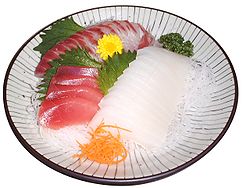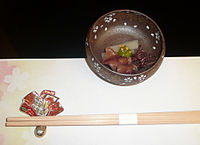Sashimi
Sashimi [ ˈsə.ʃiː.miː ] ( ) ( Japanese 刺身 , sasu for “pierce” and mi for “body”) is a popular way of preparing raw fish and seafood in Japanese cuisine . In the trade, fish of the quality required for preparation is called sashimi or sashimi quality .
General
In contrast to sushi , the fish is not served on rice . Fillet pieces are almost exclusively used for sashimi, and the way the fish is cut is also different from sushi.
Correct filleting as well as the artful and aesthetic presentation of the fish are decisive, as the 3–4 mm thick fillets otherwise do not receive any further treatment, i. H. can be served raw and unseasoned. Only a few types of fish and seafood can be pickled or cooked. A very sharp knife ( Hōchō ) is therefore important during preparation.
The freshness of the fish is very important for sashimi. Even with a slight odor, it is unsuitable for preparation. In some cases, frozen fish that has already been frozen on board the fishing vessels is used. In the Ikizukuri preparation, living sea creatures are also processed into sashimi and the fish skeleton is presented as a decoration with its head still gasping for air as proof of freshness.
Different types of fish are suitable depending on the season. This is due to the respective spawning time and the migration of the schools of fish. Since most freshwater fish should not be eaten raw because of possible fish tapeworm infestation, almost only marine fish are used for sashimi. The most common is the use of tuna. Similarly, some marine fish that spend part of their life in fresh water are only served boiled or grilled (e.g. eels , but not farmed salmon ). Wild salmon are first frozen by the natives of Japan, the Ainu , and then cut and consumed while frozen. This dish is called ruibe ( ル イ ベ ).
The ayu ( 鮎 ), which feeds mainly on a certain type of algae and therefore does not ingest parasites, and the koi carp ( 鯉 ) are among the few freshwater fish that are consumed as sashimi . Since this has a chewy texture, each slice of sashimi is placed in 50 ° C warm water by the cook for one minute and then poured into ice water. The muddy taste that is often present is also washed out ( 洗 い , “Arai”, washing).
Sashimi is served with wasabi (Japanese horseradish ), shoyu ( soy sauce ), gari (pickled ginger ), shiso ( perilla ) as well as daikon (white radish ) cut into fine threads and carrots .
To sashimi matching drinks are green tea , Japanese beer or sake .
Fish and seafood suitable for sashimi
- Akagai ( 赤 貝 ) - clam
- Amaebi ( 甘海老 ) - Pandalus borealis ( Pandalus borealis )
- Anago ( 穴 子 ) - conger eel
- Awabi ( 鮑 ) - abalone
- Ebi ( 海 老 ) - king prawn see also Odori ebi (sashimi made from live prawns)
- Fugu ( 河豚 ) - puffer fish (Takifugu)
- Hamachi / Buri ( 鰤 ) - Japanese Seriola ( Seriola quinqueradiata )
- Hirame ( 比目魚 ) - Japanese flounder ( Paralichthys olivaceus )
- Hotate-gai ( 帆 立 貝 ) - Scallop ( Patinopecten yessoensis )
- Ika ( 烏賊 ) - squid
- Katsuo ( 鰹 ) - Bonito ( Katsuwonus pelamis )
- Persimmon ( 牡蠣 ) - oyster
- Kanpachi ( 間 八 ) - Yellowtail mackerel ( Seriola dumerili )
- Kohada ( 小 鰭 ) - Spotted Pacific Herring ( Konosirus punctatus )
- Me-kajiki ( 目 梶 木 ) - swordfish
- Maguro / Toro ( 鮪 ) - tuna
- Miru-gai ( 海松貝 ) - elephant trunk clam
- Saba ( 鯖 ) - mackerel
- Sake ( 鮭 ) - salmon (especially popular outside of Japan)
- Sanma ( 秋刀魚 ) - Pacific jackfish ( Cololabis saira )
- Suzuki ( 鱸 ) - Japanese perch ( Lateolabrax japonicus )
- Tai ( 鯛 ) - sea bream ( Pagrus major )
- Tako ( 蛸 ) - giant octopus
- Unagi ( 鰻 ) - eel ( Anguilla japonica )
Some restaurants also offer chicken sashimi. Chicken breasts in particular, but also the liver or the heart of the chicken, are eaten raw. Other examples of terrestrial vertebrate sashimi are locally restricted, such as goat sashimi from Okinawa and horse sashimi, and the like. a. in Kumamoto and Aizu-Wakamatsu . Whale sashimi should also be mentioned.
Different ways of presenting sashimi
Yellowtail mackerel sashimi
Sea bream sashimi
Sawachi-ryori - sashimi after Kōchi -Art
Individual evidence
- ↑ Sushi made from live fish ( English ). Retrieved September 4, 2011.







